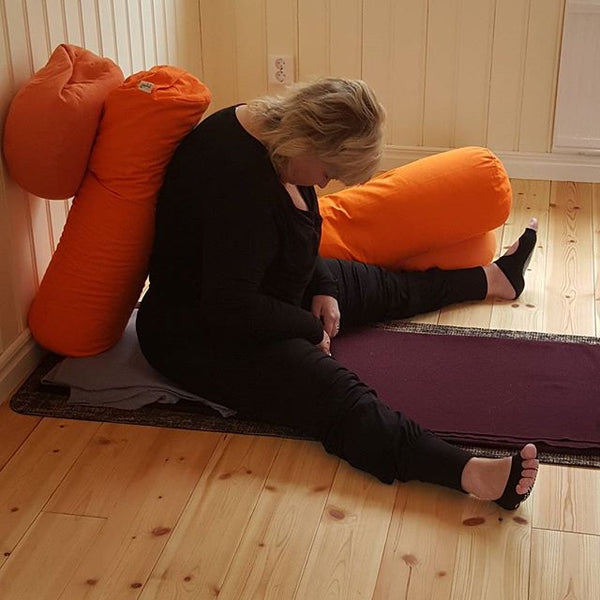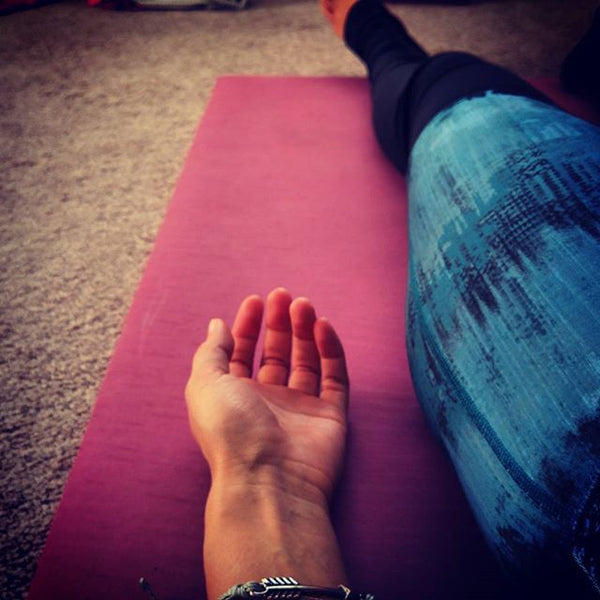Bikram Yoga: 11 Top Tips for Beginners
26 postures, 90 minutes, 104º fahrenheit. Bikram yoga is seriously challenging, but many swear by it. From its controversial founder to how you can prepare yourself for your first class, here are 11 things we learned along the way.
1. Bikram yoga is one of the most systemic and 'military' forms of yoga
Every class is conducted in a 104º fahrenheit (40.5º Celcius) room. No matter where you go, the Bikram class experience is almost the same. The 90-minute class begins and ends with pranayama (breathing) exercises. In between the breathing exercises are the 26 postures (see below) that will each be practised twice. Bikram yoga teachers are trained to give scripted verbal guidance on the postures (e.g. during forward folds, they will always ask you to not leave space between your tummy and your thigh, "just like a Japanese ham sandwich"). It is believed that practising Bikram yoga is a form of moving meditation, because as you learn to focus on the teacher's instructions and your body, you eliminate internal chatter for a more tranquil mind. [caption id="attachment_19770" align="alignnone" width="679"] The 26 postures of Bikram yoga (via monyogachaud)[/caption]
The 26 postures of Bikram yoga (via monyogachaud)[/caption]
2. What to Wear to Bikram Yoga.
There are bodies of all shapes and sizes - there is no need to feel self-conscious. Having said that, some yogis wear really short shorts. Some people we know may even be particularly motivated to practise Bikram yoga for that reason (cough, cough)... At Lotsofyoga, we don't judge! Wear what is comfortable when you have to bend, twist and fold while sweating loads! We usually opt for a sport bra top and shorts that comfortably cover the bottom (as there are a lot of forward bending poses). And many people put on a tank top, vest or t-shirt as well. We are not too sure about wearing just a bathing suit...
3. It can get really crowded
During peak hours, it is not uncommon to see very little space between mats. So... let's stack ourselves during prasarita padottanasa. It is not ideal to feel like you are sniffing someone's bottom during a wide-angle standing forward bend (maybe except if you are friends and have a lot of love for one another!). Thank you.
4. Why is Bikram yoga so addictive?
Some yoga students wear their heart rate monitor during practice to measure how changes in their heart rates correspond to the posture sequence of the Bikram yoga, such as the chart below. The sequence is built to help heart rate build up systemically, and there are two occasions where you will be allowed a longer versions of savasana (resting corpse pose): at the end of the standing sequence and at the end of the practice. To see how important the resting pose is, check out the heart rate plot below - there is an obvious drop of heart rate during the first savasana. We believe that this system allows a really nice release of tension and also help build strength and endurance. Not to mention the sheer amount of detoxing sweat and all those layers of dead skin that rubs off at the end of practice. Great for glowing skin! [caption id="attachment_19782" align="alignnone" width="599"] Amazing chart that details heart rate changes during Bikram yoga practice (via David Phillips / Google+)[/caption]
Amazing chart that details heart rate changes during Bikram yoga practice (via David Phillips / Google+)[/caption]
5. The smell: it's not as bad as you think
What is most surprising about Bikram studios is the fact that they are all furnished with carpets, as mandated by the Bikram franchise (more on this later). Given that most students sweat quite substantially in each class, you would have guessed right that the smell can be strong in a Bikram classroom. This is why it is worth trying out different studios because the difference lies in a conscientious studio that invests in making sure the rooms and mats are clean. Fortunately, in our experience, smelly studios are a minority in the community.
6. No inversions
For those who are used to a yoga practice that finishes with inversions (such as shoulder stand or head stand), you may be surprised that there are no inversions in a Bikram yoga practice. Neither are there any popular postures such as Downward Facing Dog or Chutaranga. In a way it makes Bikram a great sequence for those who find vinayasa or flow-based yoga challenging or not suitable for them. That's not to say Bikram doesn't come with its own set of challenges though... (Original comic by Alisha Brunton)
(Original comic by Alisha Brunton)
7. Lock your knees! Lock your knees!
The biggest surprise in my first Bikram yoga class is when the teacher started asking us to lock our knees. In many non-Bikram classes, we were told that locking your knees is bad because people tend to hyperextend their knees, and in time, something will give in. If you are flexible, or have the tendency to push your knees in, check out this great guide on how to lock your knees correctly from Evolation Yoga. Ultimately, you know your body and it is important to do what is right for you. [caption id="attachment_20313" align="alignnone" width="450"] Knees locked correctly[/caption] [caption id="attachment_20314" align="alignnone" width="450"]
Knees locked correctly[/caption] [caption id="attachment_20314" align="alignnone" width="450"] Knees hyperextended - not good for your joints![/caption]
Knees hyperextended - not good for your joints![/caption]
8. No adjustments
Bikram yoga is a 'dialogue-based' yoga, which means that unlike traditional yoga classes, Bikram teachers rarely adjust students physically. So expect no fancy pulls and tugs from your teacher and try to listen carefully. To those who are complete beginners to yoga, or those who are kinaesthetic learners and not that receptive to verbal cues, Bikram can be challenging and potentially a practice that can breed bad habits. So, watch out!
9. Bikram and his questionable brand
Amongst the yoga communities, there have been years of divided opinions on the founder, Bikram Choudhury, and the practice. Recently, there have been alleged sexual harassment and assault cases filed against Choudhury that seem to be the final straw to the otherwise devoted communities. New forms of yoga have started to be created by teachers classically trained through Bikram yoga, such as Fierce Grace Yoga in the UK and Modo Yoga from New York.
10. Teacher training - a pyramid scheme?
Okay, sorry but we said it! You heard us right. Not only does the Bikram yoga teacher training cost more than US$11,000 for an intense nine-week, 6-day-a-week camp in LA, Bikram-branded yoga studios around the world are required to pay a licensing fee and a monthly fee to operate. It is estimated that there are 3 million people who have practised Bikram yoga worldwide. With over 5,000 studios opened, it is estimated that Bikram Choudhury is making close to US$5 million a year, or a net worth of US$7 million. Not bad for a yogi, some would say. To put things into perspective, a recently graduated yoga teacher is only expected to make between $20-45 per hour. We smell a little pyramid here, and yet we still love that rewarding feeling after a Bikram yoga class... [caption id="attachment_19777" align="alignnone" width="600"] A hot yoga studio in Montreal, Canada (bikramhotyogatmr)[/caption]
A hot yoga studio in Montreal, Canada (bikramhotyogatmr)[/caption]
11. Things to bring
So where does that leave us? We believe that there is no right or wrong form of yoga, and you will have to decide for yourself! If, after reading all this (hurrah!), you are interested in trying out Bikram yoga, we recommend you to bring the following:- Two towels: One for absorbing the sweat during class and one for the shower afterwards. Studios usually offer them at a rate of £1.50 ($2) per towel.
- A big bottle of water and some fruits: You will need to stay really hydrated prior to the class, and at least 12 hours in advance - otherwise it is too late. We found that having some fresh fruit handy is a welcome treat after a hot yoga practice.
- Money: Bikram yoga is not cheap. A class usually costs £16 ($20), although you can get trial packs as a beginner and discounted class packs are available for those who are more committed.
- A little wash towel: You may want a little wash cloth in the shower to scrub off all the dead skin, but please try not to hold the shower for too long especially when there are people waiting in queue.
- An open heart! Despite all the controversies, you know what works best for your body. Go with an open mind and see what comes out of it. Have fun and be safe!

Do you need a Hot Yoga Towel Mat?
It's of common belief that a good yoga towel mat is a necessity for Bikram yoga (enough with the slipping and sliding already!) so we've hand-picked three of our faves for you to try out.1. Susama Yoga Towel , £19.99
, £19.99
[caption id="attachment_23038" align="alignnone" width="600"] Susama 100% Microfiber Towel[/caption] This super absorbent yoga towel by Susama is made from 100% microfibre, is non-slip and light, dries quickly and is eco-friendly. Plus it wont break the bank.
Susama 100% Microfiber Towel[/caption] This super absorbent yoga towel by Susama is made from 100% microfibre, is non-slip and light, dries quickly and is eco-friendly. Plus it wont break the bank.
2. The Manduka equa® hot yoga towel , £45
, £45
[caption id="attachment_23036" align="alignnone" width="600"] The Manduka equa® hot yoga towel in Thunder[/caption] The Manduka equa® hot yoga towel is pretty much the yoga towel authority and is as good as it gets when it comes to hot yoga towels. It's a tad pricier than the other two in this list but is sure to last you a long time and create many happy hot yoga memories.
The Manduka equa® hot yoga towel in Thunder[/caption] The Manduka equa® hot yoga towel is pretty much the yoga towel authority and is as good as it gets when it comes to hot yoga towels. It's a tad pricier than the other two in this list but is sure to last you a long time and create many happy hot yoga memories.
3. Gaiam Thirsty Yoga Towel , £22.99
, £22.99
[caption id="attachment_23037" align="alignnone" width="600"] Gaiam Thirsty Yoga Towel in Teal[/caption] The Gaiam Thirsty yoga towel mat is known to be a yogi's favourite because it's not too pricey, it's super absorbent and is sure to keep you safe and secure on your mat. Did we cover everything Bikram-related? Do you have anything to share with us or have any tips for beginners? We would love to hear from you. Please feel free to comment below, share your thoughts on via Facebook or Twitter.
Gaiam Thirsty Yoga Towel in Teal[/caption] The Gaiam Thirsty yoga towel mat is known to be a yogi's favourite because it's not too pricey, it's super absorbent and is sure to keep you safe and secure on your mat. Did we cover everything Bikram-related? Do you have anything to share with us or have any tips for beginners? We would love to hear from you. Please feel free to comment below, share your thoughts on via Facebook or Twitter.
Like the article? Follow us for more free, high-quality yoga and mindfulness content...
Subscribe to our free weekly email newsletters:Additional Reading:
- Bikram dialogue: What Bikram teachers say to you during the 90-minute class.
- An insider's guide to Bikram yoga teacher training: A rather rosy (and slightly cultish) guide (apologies if you find this comment offensive!)
- Week seven at Bikram yoga teacher training: Very, very funny! A real first-person's account on what it's really like during a Bikram teacher training session.
- "The Overheated, Oversexed Cult of Bikram Choudhury": Quite harsh. Given that we practise Bikram yoga at times, it's not necessarily a cult all the way, but we see where that accusation comes from.
- Yoga Journal's interview with Bikram Choudhury: Telling, neutral, bemusing.
- "Bikram Feels the Heat": An in-depth report into the 'cults' and culture of Bikram yoga teacher training and the sexual assault back stories.



